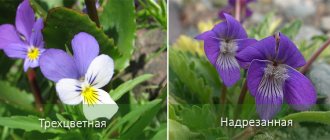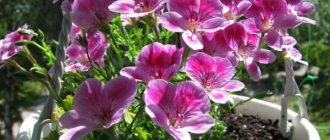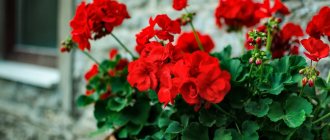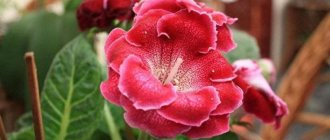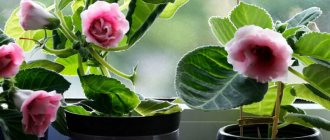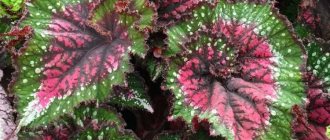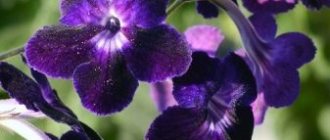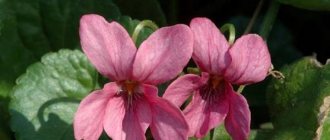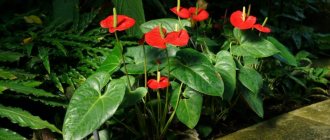Description
Pelargonium Anita belongs to rosebud varieties , which means it can boast of wonderful decorative buds that resemble roses in shape. The variety is enjoying increasing attention and love from flower growers due to its high decorative qualities and relative ease of cultivation.
REFERENCE! Pelargonium Anita is a product of artificial selection. In general, rosebud pelargoniums were born thanks to an artificial mutation. The specific characteristics have taken root, and now rosebuds are a separate, widespread variety of pelargonium.
Anita is distinguished by good growth and does not require too much attention and care. The shape of the bush is compact and does not require too careful and frequent pruning.
Pelargonium Denise
Zonal, double pelargonium Denise forms large, vigorous bushes, which are annually decorated with bright caps of peach or pink flowers. The densely double flowers in the shape of half-opened roses are very large, and the corollas do not open until the end of flowering. The middle petals have a light, delicate color, and the lower layers are brighter. At the point where the petal attaches to the peduncle, the color may be greenish. This variety is famous for its beauty, abundant flowering and grateful attitude to care. Pelargonium is unpretentious and easy to grow.
Appearance Features
Pelargonium Antita can boast of the highest decorative qualities . The flowers of the plant are large, very similar to roses, having a pale pink color and a large number of delicate petals. The flowers have a regular round shape, their core is closed, and the formed caps are dense and quite large. The peculiarity of the variety is its beautiful glossy light green leaves, against which the delicate beauty of the flowers is even more noticeable.
The variety blooms wonderfully: the plant is able to form quite a lot of inflorescences during the season, which gives the bush a lush, elegant appearance.
The height of this pelargonium bush reaches half a meter. Note that thanks to phytoncides, the plant has a beneficial effect on the microclimate of the room , killing pathogens in the air.
The best varieties
As already mentioned, zonal pelargonium has more than three hundred species. The most common are:
- Calliope Dark Red is a recently developed hybrid. The authors of this variety in the description always indicate the magnificent appearance of Calliope Dark Red - rich red double buds are located on a medium-sized bush;
- another medium-sized variety, Rafaella, differs from Calliope Dark Red in larger inflorescences and a variety of shades - from pale pink to lilac;
- Chandelier Violet blooms with purple buds from May to October. This variety is suitable for both outdoors and indoors, and with proper care it will delight you with large inflorescences sitting on bright green stems;
- pelargoniums of the PAC group (known in our country as PAK) are more expensive hybrids. Most of them were bred in the last two decades. PAK varieties are distinguished by a wide variety of colors and shapes - flowers similar to roses and classic geraniums, white, blue and all shades of red. In our country, the most famous geranium hybrids are under the following names - PAC Fireworks Red, PAC Fireworks Red-White, PAC Salmon Princess, PAC Viktor Improved. , PAC Viva Carolina (PAC Viva Carolina);
- The incredibly beautiful hybrid Red Pandora belongs to the tulip-shaped varieties. Red Pandora inflorescences resemble a set of small tulips of a soft scarlet color. The variety blooms for a long time and does not require serious care;
- pelargonium Montevideo grows into huge peony-shaped buds of a delicate salmon color. The plant is medium-sized and suitable for growing in an apartment;
- Unicorn Zonartic Rose is a vigorous growing species obtained by crossing the flowers of the golden variety Lara Zonartic and the purple variety Lara Suzanne. The result was a plant with soft purple petals and large double leaves;
- Another group of pelargoniums is Deacons. In this group there are plants of various shades - platinum, orange, white, burgundy and others. The flowers are short, with sparse foliage. A number of varieties are bred in Italian Tuscany (Kato, Claudio, Eric, Bernd), while others (Cupid, Emma Housley) are native to other European countries.
Photo
Meet this beautiful flower in the photo:
Landing
Let's find out what requirements Anita places on her habitat: we'll find out where to place the pot with this plant, what conditions it needs for successful growth and flowering.
Location and lighting
IMPORTANT! Rosebud pelargonium is afraid of direct sunlight, which can leave burns on its delicate petals and lead to the plant losing its decorative qualities.
Therefore, place the plant on windowsills, protected from bright sun . Note, however, that when growing a plant outdoors, sunlight ceases to be dangerous: and in this case, Anita does not require shading.
Temperature
The plant does well in moderate ambient temperatures. Note that too low a temperature is not suitable for Anita, so do not allow the plant to remain for a long time at temperatures below +10 degrees. Otherwise, flower diseases are likely, including incurable blackleg, loss of decorative qualities, poorer health and lack of flowering.
Note that in the summer you can take the plant out into the open air . Rosebud pelargoniums feel good in the air, and Anita is no exception. We note, however, that if the temperature drops significantly, the plant should definitely be brought back into the house, since Anita has difficulty withstanding long periods of cold weather.
Soil Features
For Anita pelargonium, it is important to choose the correct soil composition. The soil in which the plant is located must be nutritious and breathable. The following soil mixture is best suited for this variety :
turf soil - 4 parts;- peat soil - 2 parts;
- coarse sand - 1 part;
- fine perlite - 1 part;
- humus - 2 parts.
If you don’t want to mix the soil yourself, use ready-made soil mixtures, which are widely available on the market. Choose those mixtures that say “for geraniums” or “for pelargoniums.”
Please note that the acidity of the soil in this case should be neutral or very slightly acidic. Significantly acidified soil of rosebud pelargonium is not suitable .
Care
Let's get acquainted with the main points for caring for pelargonium Anita.
Watering
As for soil moisture, Anita loves moderate watering. The soil should not be dry, however, and the flower will not tolerate swamps either. If the leaves of a flower can wither due to the soil drying out, then waterlogging is dangerous because the root system can rot.
ATTENTION! It is recommended to water when the top layer of soil is noticeably dry. To make sure of this, touch the soil with your finger: if there is a dry crust, water the flower under the root with soft, settled water.
Trimming
In order for the pelargonium bush to take on a compact and regular shape, it must be periodically adjusted - pruned. Usually Anita is pruned after flowering , since it is dangerous to perform the procedure in the spring: there is a possibility of cutting off the formed inflorescences.
Young shoots that grow quickly must be pinched. The procedure is performed when 3-4 leaves appear on the shoot. Pinching will help stop the growth of the shoot and will promote its lateral branching.
Top dressing
In order for Anita to please the eye with its lush flowering for a long time, the plant must be periodically fed. It is best (and easier) to use ready-made mineral complexes intended for pelargoniums and geraniums. Please note that during the flowering period, Anita needs potassium and phosphorus so that it blooms more luxuriantly and for a longer period of time.
In winter there is no need to feed pelargonium. During this period, the plant hibernates, recovers and prepares for the new growing season: it is better not to disturb it at this time.
Reproduction
The exotic plant can be propagated vegetatively (by children) or by seeds. Most often, gardeners prefer the first method, since seed propagation will require a lot of time and effort.
Reproduction by children
Side shoots are called children. Their rapid growth is observed during the flowering period. One plant can produce 3–8 daughter shoots.
- After flowering ends, young 10-centimeter shoots that have formed roots are planted separately.
- The soil for planting is prepared from peat and sand mixed in equal proportions.
- After 2-3 months, when the daughter shoots have taken root and become stronger, they are replanted using a soil mixture for orchids.
If only one baby is formed, the process will be significantly simplified. It is enough to remove the old plant to make room for the daughter shoot. Young tillandsia will bloom in 2–3 years.
When 4 to 6 leaves appear on the side shoots and adventitious roots are formed, they can be carefully separated from the base of the flower and planted in separate pots filled with a mixture of sand and peat in equal parts.
- Sprinkle the cuts with crushed charcoal.
- Place the pots with shoots in a slightly shaded place with an air temperature of 22 - 25°C.
- After a couple of months, young, strong plants are transplanted to a permanent place in a pot with soil, as for adult plants.
- Flowering will begin in two years, maybe a little earlier.
If tillandsia refuses to bloom, spray it with zircon solution - this will stimulate it to bloom. If only one or two children have formed, you can leave them in the same place by carefully trimming and removing the dried mother plant. Soon new full-fledged tillandsias will grow in the flowerpot, which in two years will give you bright colorful inflorescences with flowers.
Propagation by seeds
To germinate seeds, use a well-moistened mixture of sand and peat. The seeds are scattered over the surface of the substrate, without sprinkling with anything. Cover the container with glass or film and place it in a bright, warm (about 25⁰C) place.
Second way
Prepare a container with a lid or other container for germinating seeds.
- Fill it with a soil mixture of sand and peat.
- Spread the seeds, not too thickly, over the surface, gently moisten them with a small spray bottle and close the lid of the container or cover another container with plastic wrap.
- Place your crops on a well-lit windowsill with an air temperature of at least 25°C.
Shoots should appear a month after sowing the seeds. Flowering of such plants usually occurs after five years.
Pests and diseases
Like any other indoor flower, rosebud pelargonium can also be threatened by diseases and dangerous harmful insects that can completely destroy the flower.
Next, we will get acquainted with the most dangerous diseases and pests for this variety.
Diseases:
The greatest danger for this plant is root rot. The disease occurs due to improper care and maintenance: if the room temperature is too low and with excessive watering, the roots of the flower begin to rot.
REFERENCE! This disease cannot be treated, and the only measure to save the flower from rot is limiting watering and observing the temperature regime.
Pests:
Of the insects, the most dangerous for Anita are the spider mite and the whitefly. Aphids can also damage the plant. To cope with insects, it is necessary to use insecticides, and also, for preventive purposes, regularly inspect the leaves to detect pest larvae.
Pelargonium Achievement
Pelargonium Achievement is another of the rosaceous Ivy hybrids, giving the owner beautiful delicate flowers with pink silk petals with a noble shine.
How to preserve chrysanthemums in a vase - “second life” for flowers in a few minutes
As befits a hybrid pelargonium, the variety has decorative textured foliage. On leaf blades, with proper lighting, a contrasting zonal ring becomes visible.
A powerful bush of standard sizes grows easily, produces lateral stems and is not capricious. The peculiarity of the variety is the late onset of flowering.
Sources
- https://dacha.expert/domashnie-rasteniya/tsvetushhie/pelargoniya/vidy-p/anita.html
- https://selo.guru/rastenievodstvo/derorativ/pelargonija/vidy-pel/anita.html
- https://www.glav-dacha.ru/sorta-rozocvetnyh-pelargonij/
[collapse]
How to reproduce?
This variety of pelargonium, being picky in care and maintenance, shows a little of its “character” when propagated. However, following planting and germination technology will help you grow a healthy and strong plant.
- Note that rosebud pelargoniums reproduce at home exclusively by cuttings , since during seed propagation these hybrids do not inherit maternal qualities. That is, from seeds you will get ordinary pelargonium, but not rosebud.
- In this case, cuttings can be carried out year-round . But experienced flower growers advise propagating Anita from March to July. Below is a detailed algorithm for the propagation procedure of this plant.
The first step is to separate a suitable apical cutting from five to seven centimeters long from the mother plant. It is important that the cuttings are semi-lignified, as soft green young shoots will not take root. It is necessary to cut off the process with a sharp knife with a sterile blade.- Use purchased soil for planting , since self-prepared soil will require thorough disinfection. And this procedure at home is quite difficult to carry out correctly.
- The cut cuttings are dried and planted in a plastic cup , where you must first make holes for drainage, filled with an earthen mixture. Before planting, it is important to cut off all the leaves from the bottom of the petiole (which will be underground) so that they do not rot underground.
- Within two to three weeks the cutting will take root . Water it carefully immediately after planting, avoiding flooding, but also not overdrying. You should water strictly at the root, or better yet, pour water along the edge of the glass. Use water sparingly so that the cuttings do not begin to rot before rooting.
- For successful rooting, it is important that the cuttings are well lit. If this happens during short daylight hours, provide the plant with additional artificial lighting.
IMPORTANT! The cutting should not be covered with anything, as this measure can lead to rotting of the shoot.
Pelargonium is famous for its diverse varieties. Read about Pak Salmon Comtesse, Stellar, Denise, Norland, Clara Sun, Rococo, Red Pandora, Grandiflora, Lady Gertrude, Patricia Andrea.
Reproduction methods
Pelargonium can be propagated by sowing seeds and cuttings. For growing, it is convenient to take seeds coated with nutrients and plant them in a container with moist soil without deepening them. After 3–6 days, green shoots will appear. Grown plants are transplanted into small pots, and then into flowerpots. Many hobbyists prefer to propagate pelargonium by cuttings. At the end of February, the shoots that have grown over the winter are pruned so that new branches grow from the lateral buds. The cuttings need to rest for several hours so that the cut is covered with a film. After this, you can begin to root the plant.
To do this you need:
- prepared cuttings;
- Plastic container;
- drug "Kornevin";
- peat tablets;
- water.
Let's start rooting:
- Place peat tablets in a container according to the number of cuttings;
- Water the tablets a little, they will increase in volume;
- Use a stick to deepen the holes in the tablets for planting;
- dip the stem of each cutting in “Kornevin” - a root formation stimulator;
- we plant the shoots into tablets.
